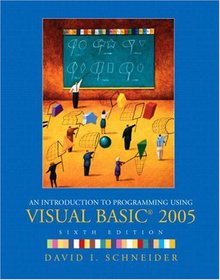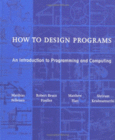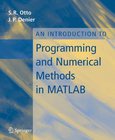An Introduction to Programming
Using Visual Basic 2005
6th Edition

Book Details:
| Publisher: | Prentice Hall |
| Series: | Prentice Hall , Using |
| Author: | David I. Schneider |
| Edition: | 6 |
| ISBN-10: | 0130306541 |
| ISBN-13: | 9780130306548 |
| Pages: | 752 |
| Published: | Mar 13 2006 |
| Posted: | Nov 19 2014 |
| Language: | English |
| Book format: | CHM |
| Book size: | 7.69 MB |
Book Description:
Based on the newest version of Microsoft's VB. NET, this revision of Schneider's best-selling guide is designed for readers with no prior computer programming experience. The author uses Visual Basic .NET 2005 to explore the fundamentals of programming, building a strong foundation that will give students a sustainable understanding of programming. Offers a broad range of examples, case studies, exercises, and programming projects to give readers significant hands-on experience. Includes a new section on Graphics. Provides fully updated example text and data, including tax codes, social security forms/data, baseball statistics, and more. Contains all new, robust, interesting programming projects. Updates screenshots throughout using Windows XP. Bundles Visual Basic .NET Express automatically with each copy of the text. A useful reference for both beginning and experienced programmers who want to learn more about the latest version of Microsoft's VB. NET.
Download Link:
Related Books:
How to Design Programs
An Introduction to Programming and Computing
This introduction to programming places computer science in the core of a liberal arts education. Unlike other introductory books, it focuses on the program design process. This approach fosters a variety of skills--critical reading, analytical thinking, creative synthesis, and attention to detail--that are important for everyone, not just future computer programmers.The book exposes readers to two fundamentally new ideas. First, it presents program design guidelines that show the reader how to analyze a problem statement; how to formulate concise goals; how to make up examples; how to develop an outline of the solution, based on the analysis; how to finish the program; and how to test. Each step produces a well-defined intermediate product. Second, ...
An Introduction to Programming in Emacs Lisp
Emacs Lisp is a simple, complete, and powerful programming language. It is the building block of GNU Emacs, which is an integrated development environment with special features for scanning and parsing text as well as for handling multiple files and sub-processors. This book will show you: * how to set variables and write function definitions * How to use "if" and "let" * How to write "while" loops and recursive loops * how to search for a word or expression * how to customize GNU Emacs for yourself, even when it is shared on a network. * how to debug programs * and much more. This tutorial an elementary introduction to teach non-programmers how to customize their work environment; it can also be used as an introduction ...
An Introduction to Programming and Numerical Methods in MATLAB
An elementary first course for students in mathematics and engineering Practical in approach: examples of code are provided for students to debug, and tasks with full solutions are provided at the end of each chapter Includes a glossary of useful terms, with each term supported by an example of the syntaxes commonly encountered...
2007 - 2021 © eBooks-IT.org



